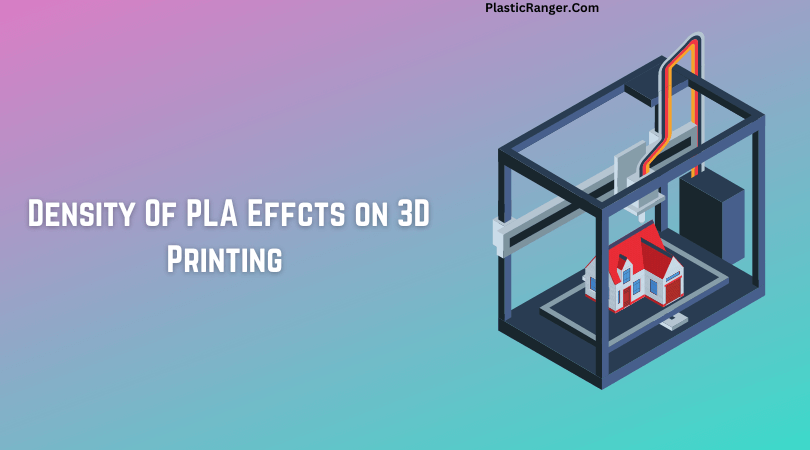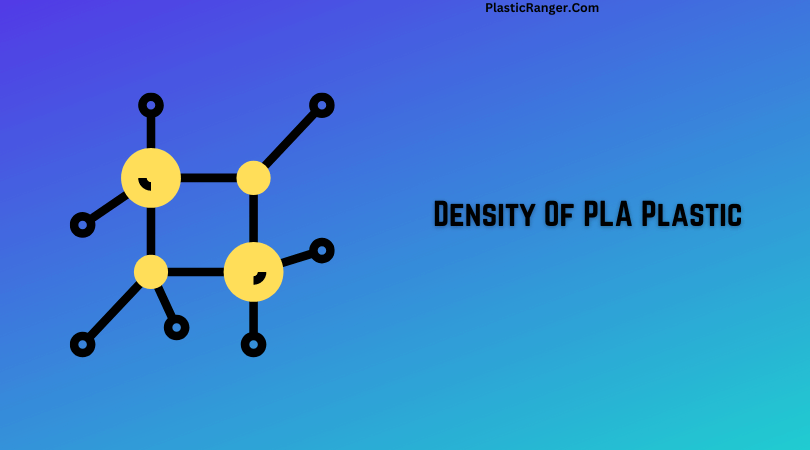Density of PLA
Plastic material density is defined as the mass per unit volume of the material, typically measured in either grams per cubic centimeter (g/cm³) or kilograms per cubic meter (kg/m³).
PLA density is 1.25 g/cm3 g/cm3 and 1240 kg/m3.
The density of the popular biodegradable plastic is slightly higher than water (1 g/cm³). This is notably less dense compared to many frequently used petroleum-based plastics such as polyethylene (with a density range of 0.92 to 0.96 g/cm³) and polypropylene (with a density range of 0.9 to 0.92 g/cm³)
Before diving into the PLA plastic density shebang, I want to clarify how plastic material density is measured.
What is Density?
Plastic density is the measurement of a substance’s mass about its volume. It is a critical physical property that characterizes a material and influences its behavior in various conditions. The density can be represented in grams per cubic centimeter (g/cm³) or kilograms per cubic meter (kg/m³).
Factors That Affect the PLA Density
Several factors can influence the density of PLA, including the kind of starch or sugar utilized as the raw material, the method of production, and the addition of fillers or additives.
The type of starch or sugar used as the raw material can significantly impact the density of the final product.
For example, corn starch typically has a higher density than sugarcane or potato starch, which can result in a denser final product.
How PLA is produced can also influence its density. This is because factors such as the alignment of the polymer chains during production can impact the density of the resulting product.
Additives and fillers can alter the PLA’s density. Fillers can increase density, while certain additives can lower it by creating voids within the material.
The type and amount of additives used determine the final density of the plastic.
Influence of Temperature on PLA Density
The temperature conditions during its processing significantly affect the density of polylactic acid (PLA).
Elevating the temperature often results in the polymer chains acquiring more flexibility, thereby decreasing the material’s density.
Conversely, when PLA is processed at cooler temperatures, the polymer chains tighten, becoming less flexible and more rigid, increasing the material’s density.
Another impacted Characteristic beyond density is the processing temperature also dictates various other mechanical and thermal attributes, including but not limited to tensile strength, rigidity, and flexibility.
For example, a higher processing temperature might result in a PLA variant that’s more flexible but less strong, making it well-suited for applications like flexible packaging or medical stents.
Conversely, a lower processing temperature would yield a stronger, more rigid PLA suitable for use in structural applications, such as rigid packaging and construction elements
How Does PLA Density Affect Its Processing?
Melt Viscosity
The viscosity of the melted PLA is directly related to its density. A higher density usually results in higher viscosity, making the material more difficult to process. This can lead to poor flow, increased melt temperatures, and longer processing times, impacting the product’s final quality.
To mitigate these issues, manufacturers may use specialized processing equipment or adjust processing conditions, such as PLA melting point and pressure.
Mechanical Properties
The density of PLA can also impact its mechanical properties, such as strength, stiffness, and toughness.
A higher density will generally produce a more robust and stiffer material but may also be more brittle.
On the other hand, a lower density may result in a more flexible and impact-resistant material, but it may also be weaker.
The specific mechanical properties of PLA will depend on the density and the particular formulation and processing conditions used.
Thermal Properties
The density of PLA impacts its thermal properties, including thermal stability, heat conduction, and thermal expansion.
A higher-density PLA enhances its thermal stability and heat conduction due to the increased bonding between its polymer chains.
Conversely, a lower-density PLA reduces thermal stability and heat conduct
tion due to decreased bonding, gaps, and faults within the material.
Physical Properties
The density of polylactic acid (PLA) significantly influences its physical properties. As PLA density increases, the material becomes more compact and exhibits enhanced strength and stiffness.
Higher density also contributes to improved dimensional stability and heat resistance.
Conversely, lower density in PLA results in increased flexibility, lower strength, and reduced heat resistance.
By skillfully manipulating PLA density, manufacturers can tailor the material’s properties to meet specific application requirements, balancing strength, flexibility, and thermal characteristics.
Chemical Properties
Its density influences the chemical properties of polylactic acid (PLA). PLA density impacts the material’s solubility and permeability to different chemicals.
Higher density in PLA leads to reduced chemical permeability, making it more resistant to the penetration of certain solvents and substances.
On the other hand, lower density increases the material’s susceptibility to chemical attack and may result in increased solubility. Skillful control of PLA density allows for precise tuning of its chemical resistance, enabling its application in environments where resistance to specific chemicals is desired.
Applications of Low Density and High-Density PLA
Talking first about low-density PLA is typically used for applications that require flexibility, such as packaging, toys, and textiles. In these applications, the material’s low density makes it more flexible and more accessible to form into the desired shape.
Conversely, high-density PLA is favored for applications that demand rigidity and strength, such as medical devices like implants and prosthetics, automobiles, and construction. The increased density in this type of PLA offers improved rigidity and strength, making it a suitable option for these crucial applications.
How Density of PLA Affects 3D Printing

PLA plastic is most famous for its variety of applications in 3D printing.
Some of the most common applications of PLA with 3D printing are Food packaging and containers, Toys and figurines, Replacement parts and functional objects, home décor items such as vases and lamps, Phone cases, and other electronic accessories, etc.
The method of 3D printing is all about layer adhesion water FDM, SLA, or SLS. The material’s quality determines the flow behavior during the printing process.
A higher density PLA leads to a higher viscosity of the melt and a slower cooling rate, which can result in incomplete layer fusion and poor layer adhesion.
On the other hand, a lower-density PLA results in a lower viscosity of the melt and a faster cooling rate, which can lead to improved layer adhesion and reduced warping.
However, this also reduces the mechanical properties of the final product, such as strength and toughness.
The Conclusion
The density of PLA plastic can vary depending on the manufacturer and production process. However, on average, PLA plastic has a 1.25 g/cm3 density, making it a lightweight and sustainable alternative to traditional petroleum-based plastics.
Its biodegradability and low environmental impact make it a popular choice for consumer products, packaging, and medical applications. Despite some limitations, the increasing demand for eco-friendly solutions makes PLA a promising material for the future.
Quick Navigation

